广东省江门市第一中学2016-2017学年高二英语必修五 Module 5 Unit 1 Great scientists Warming up26Reading1(课件) (共42张PPT)
文档属性
| 名称 | 广东省江门市第一中学2016-2017学年高二英语必修五 Module 5 Unit 1 Great scientists Warming up26Reading1(课件) (共42张PPT) | 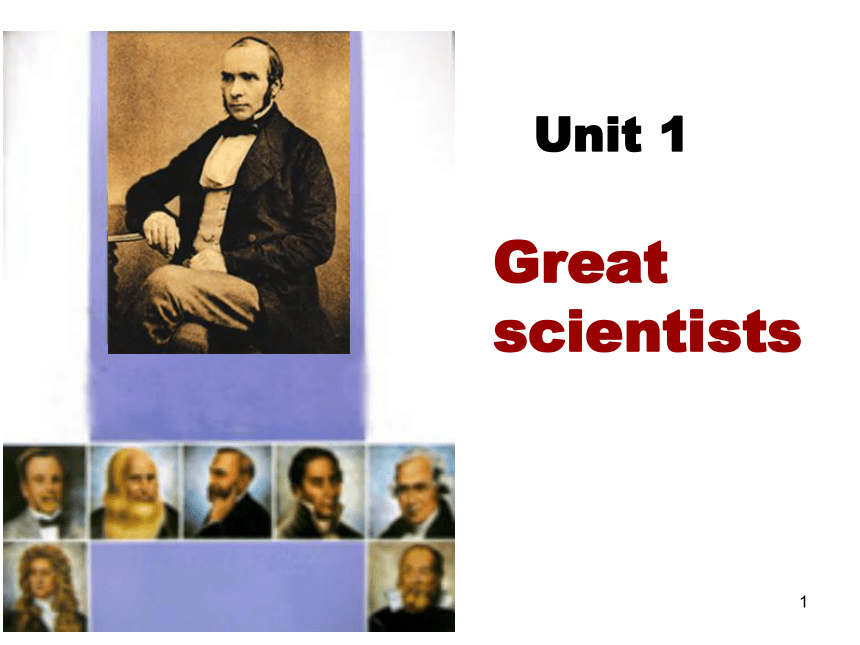 | |
| 格式 | zip | ||
| 文件大小 | 1.2MB | ||
| 资源类型 | 教案 | ||
| 版本资源 | 人教版(新课程标准) | ||
| 科目 | 英语 | ||
| 更新时间 | 2016-09-07 12:14:21 | ||
图片预览


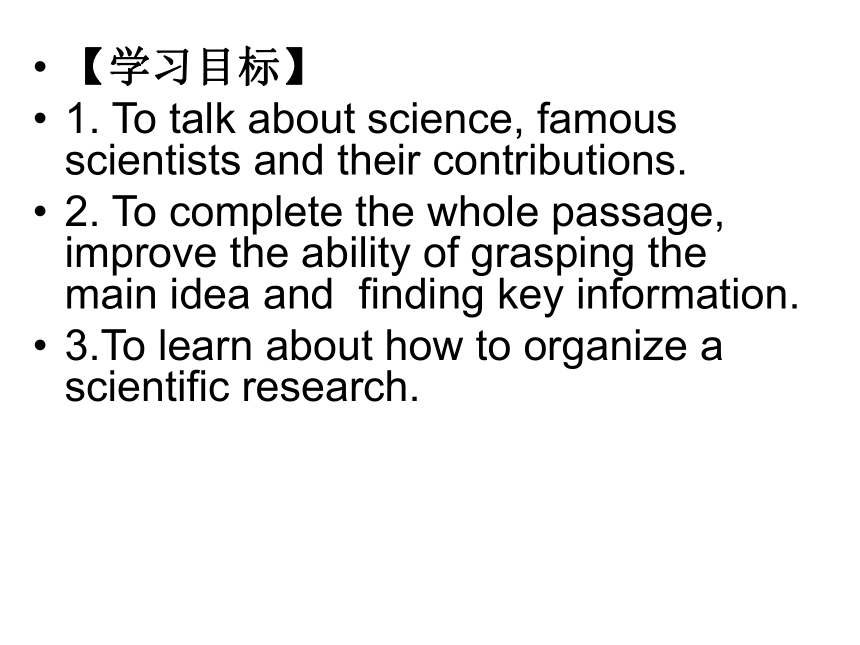
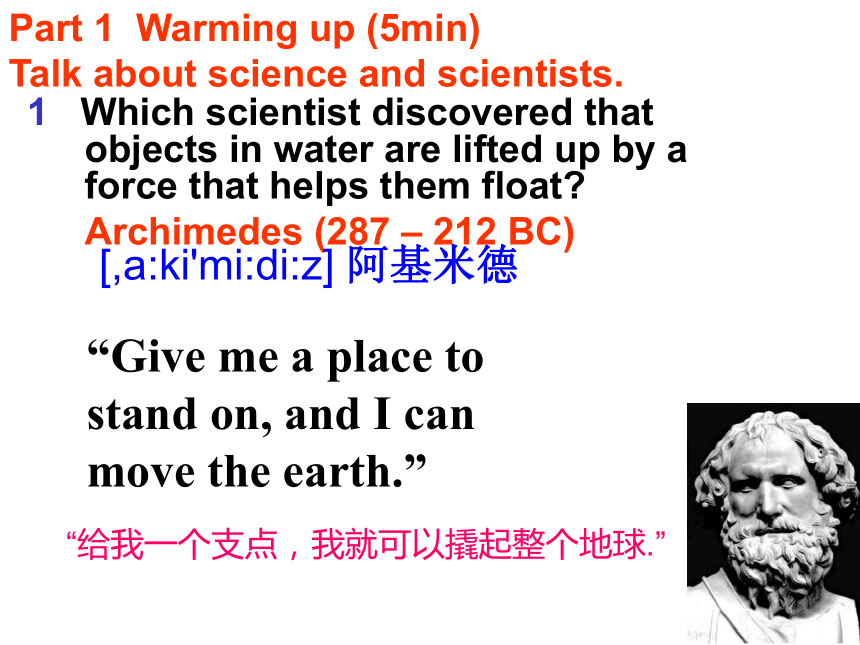



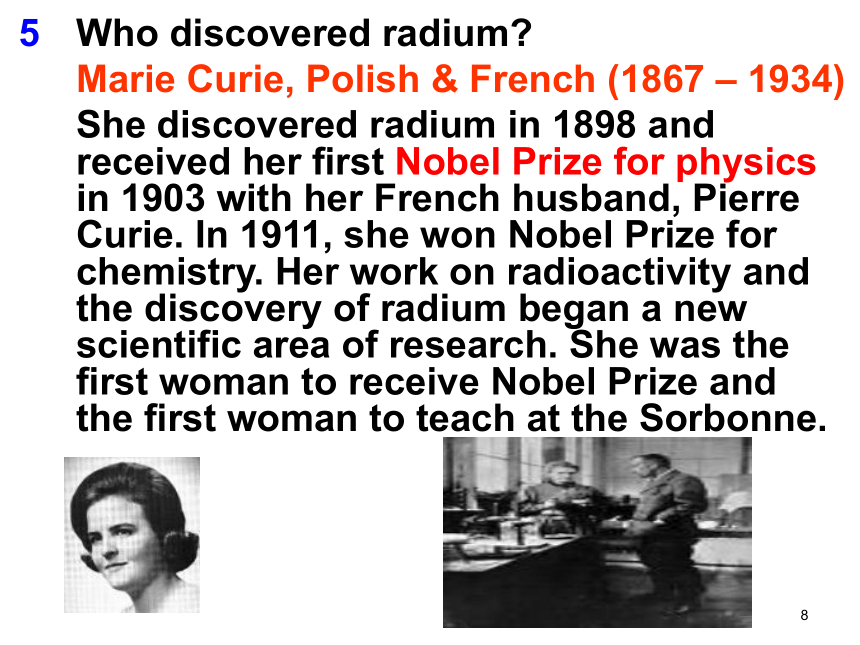

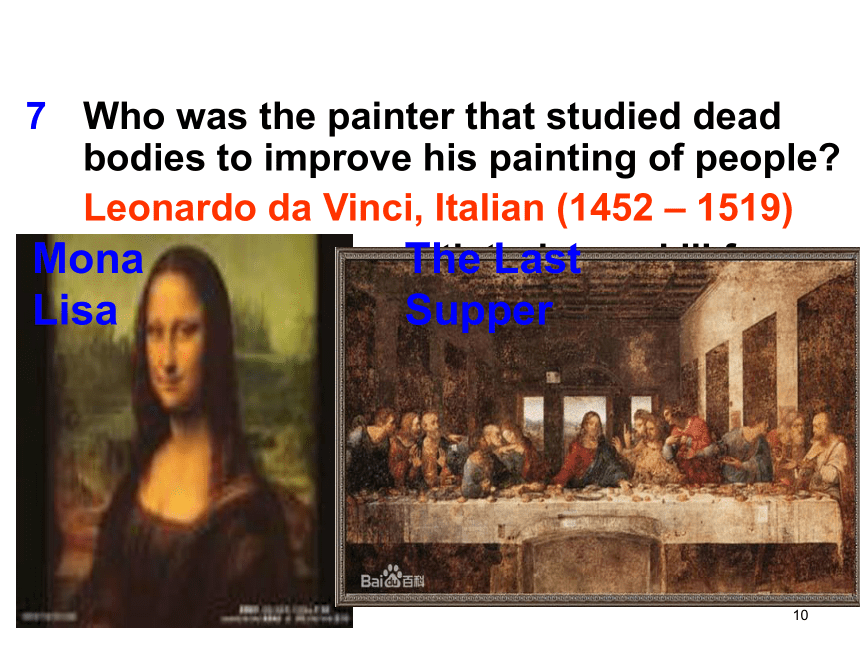
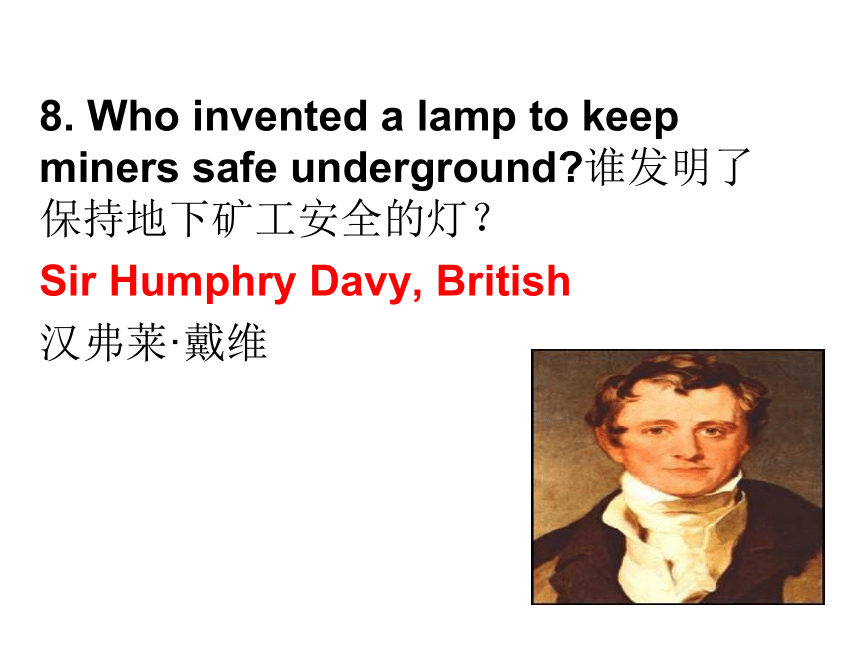

文档简介
课件42张PPT。1Unit 1Great scientistsWarming up and Reading1 导学案
【 使用说明与学法指导】
1.自学:25分钟自学课文P1-3页课文,独立完成导学案题目,并上交。
1)先快读浏览课文,获取文章大意,完成Task 1;快速阅读课文,获取关键信息,完成Task 2。
2)进一步阅读课文,理解文章结构,完成Task 3.
3)仔细阅读文章,理解重点短语和长难句,完成Task 4&5.
2.合作探究:自主思考,有疑问之处留待课堂讨论,如Task 3&5.【学习目标】
1. To talk about science, famous scientists and their contributions.
2. To complete the whole passage, improve the ability of grasping the main idea and finding key information.
3.To learn about how to organize a scientific research.4Part 1 Warming up (5min) Talk about science and scientists. 1 Which scientist discovered that objects in water are lifted up by a force that helps them float?
Archimedes (287 – 212 BC)
[,a:ki'mi:di:z]?阿基米德“Give me a place to stand on, and I can move the earth.”“给我一个支点,我就可以撬起整个地球.”52 Who wrote a book explaining how animals and plants developed as the environment changed?
Charles Darwin, British (1809 – 1882)
The Origin of Species物种起源was published in 1859. It explained how plants and animals had changed over time to fit in with a changing environment. His book showed that human had developed from apes instead of coming from Adam and Eve, who had been made by the God, according to the Bible. 物种起源63 Who invented the first steam engine蒸汽机?
Tomas Newcomen, British (1663 – 1729)
He improved the first steam pump built by Thomas Savery in 1698 and turned it into a steam engine for taking water out of mines in 1712. James Watt improved it still further in the 1770s turning it into the first modern steam engine used on the railways.74 Who used peas to show how physical characteristics are passed from parents to their children?
Gregor Mendel), ?Austrian (1822 – 1884)
孟德尔(奥地利遗传学家)He grew pea plants and developed ideas on heredity and inherited (遗传的) characteristics. He concentrated on cross-fertilising杂交pea plants and analyzing the results. He examined seven kinds of seed and plant characteristics and developed some laws of inheritance.遗传85 Who discovered radium?
Marie Curie, Polish & French (1867 – 1934)
She discovered radium in 1898 and received her first Nobel Prize for physics in 1903 with her French husband, Pierre Curie. In 1911, she won Nobel Prize for chemistry. Her work on radioactivity and the discovery of radium began a new scientific area of research. She was the first woman to receive Nobel Prize and the first woman to teach at the Sorbonne.96 Who invented the way of giving electricity to everybody in large cities?
Thomas Edison, American (1847 – 1931)
He was already an inventor of other electrical devices (phonograph, electric light bulb) when in 1882 he designed a system for providing New York with electricity from a central power station. This was a tremendous achievement, which had previously been thought impossible.
One of his famous instructions is: Genius is one percent inspiration and ninety-nine percent perspiration. 天才是百分之一的灵感加上百分之九十九的汗水。107 Who was the painter that studied dead bodies to improve his painting of people?
Leonardo da Vinci, Italian (1452 – 1519)
He was a famous artist whose skill for showing human skin tones made his paintings seem to come alive. His famous paintings include
“Mona Lisa” , “The Last Supper”. Later in his life, he lived in France where he designed a submarine and a flying machine.Mona LisaThe Last Supper8. Who invented a lamp to keep miners safe underground?谁发明了保持地下矿工安全的灯?
Sir Humphry Davy, British
汉弗莱·戴维
9.Who invented the earliest instrument to tell people where earthquakes happened?
Zhangheng (78–139)
the Eastern Han Dynasty in China.
Seismograph?
['sa?zm?(?)grɑ?f]
地震仪1310 Who put forward a theory about black holes?
Stephen Hawking, British (1942 – )
He has worked in astronomy and studied black holes in space. He has shown that black holes do not only absorb everything around them but, from time to time, throw out matter as well. This may make the beginning of new galaxies. This is an advance on the old theory which said that black holes “eat” everything they come across. Stephen Hawking (1942--) British, a physicistBlack hole Steven Hawking
Thomas Edison
Thomas Newcomen
Zhangheng
Charles Darwin
Madame Curie
Gregor Mendel
Leonardo da Vinci
Archemedes
Sir Humphry Davy 1234567891016Column A Column B
Alexander Bell aspirin
Thomas Edison the first telephone
Waston/Crick Evolution
Wright Brothers the electric lamp
Charles Darwin germs
Madame Curie black holes in Universe
Heinrich Dresser electricity
Louis Pasteur DNA
Benjamin Franklin the first plane
Steven Hawking the Theory of Gravity
Elbert Einstein Radium
Isaac Newton Theory of Relativity
17Column A Column B
Alexander Bell aspirin
Thomas Edison the first telephone
Waston/Crick Evolution
Wright Brothers the electric lamp
Charles Darwin germs
Madame Curie black holes in Universe
Heinrich Dresser electricity
Louis Pasteur DNA
Benjamin Franklin the first plane
Steven Hawking the Theory of Gravity
Elbert Einstein Radium
Isaac Newton Theory of Relativity
18John Snow defeats “King cholera”ReadingPart 2 Reading the passage
Step 1 Fast Reading (5min)
Task 1: What’s the main idea of the passage?
A.John Snow was a well-known doctor in London.
B.The cause of Cholera was polluted water.
C.The source of all drinking water should be examined.
D. How did John Snow collect, analyze data and find the cause of the disease and solved it .DTask 2:Scan the text and answer the questions.
21What are the two theories John Snow got interested in?
2. What did John Snow’ experience show?
The two theories are : The first suggested that cholera m________ in the ______. The second suggested that people a________ this disease into their _________ with their _______ .mealsairbsorbedbodiesultiplied John Snow had shown that c________ was spread by ______ and not in a cloud of ______. holeragermsgas223. How to prevent the disease happening again?
To prevent this from happening again, John Snow suggested that the s_____ of all water supplies (should) ______ __________ and new m_______ of dealing with p_______ water be found.ourcebe ethodsollutedexaminedStep 2 Further Reading (10min)
Pre-task: Do you know how to prove a new idea in scientific research? Here are the stages in setting out a new scientific idea. What order would you put them in?
Draw a conclusion
Think of a method
Collect results
Make a question
Find a problem
Analyse the results
Find supporting evidence1.——Find a problem
2.——Make a question
3.——Think of a method
4.—— Collect results
5.——Analyse results
6.——Find supporting evidence
7.——Draw a conclusion
Deadly disease: cholera outbreak in London
Task3 Read the passage and finish the chart below.Find a problem Make a question Gather information about where people were ill and died and where they got their water Think of a method Two possible theories Mark information on a map to find out where people died or did not die Analyse results Analyse the water to see if that is the cause of the illness. Collect results Find supporting evidenceFind other evidences to support his conclusion Make a conclusion The polluted dirty source of drinking water was to blame for the cause of the London cholera. Step 3 Close reading (15min)
Task 4. Underline the phrases in P1-3
1.put forward 提出
2.draw a conclusion 得出结论
3. expose (…)to ... 暴露(…..)于……
4. face the challenge 面对挑战
5. absorb... into... 吸收
6. be to blame 应该受责备(用主动形式表示被动)
7. look into…调查;了解;研究
8. link...to... 将…和…连接或联系起来
(be linked to…)
9. die of 因…而死亡(内因)/die from 因…而死亡(外因)【合作探究】
Task 5.长难句分析
Underline the following sentences in the text and answer the questions.
1. So many thousands of terrified people died every time there was an outbreak.
every time在此句中的作用是_________________.翻译成________________.
和它有类似用法的短语有each time, any time, next time, the first time, the last time等。充当连词“每次”(1) 每次我去看他,他都是在教室里看书.
___________________________, he is absorbed in reading in the classroom.
(2) 每当我听到这首音乐,我就想起我的童年。
_______________________________, I will think of my childhood.Every time I go to see himEvery time I listen to the musicimmediately,
directly,
instantly
the instant,
the moment,
the minute,
the second,
与 every time
一样,都可以用作连词引导时间状语从句,
意为 “一…..就”
=as soon as。
2) I will give the letter to him immediately
I see him.
→
3) I came directly I got your letter.
→
I will give the letter to him as soon as
I see him.我一见到他就把这封信给他。我一接到你的信就来了。
I came as soon as I got your letter.
2. A woman, who had moved away from Broad Street, liked the water from the pump so much that she had it delivered to her house every day.
have sth done 让某人干某事,请别人干某事;遭遇某事;
(1) 你最好明天请人把那扇破门修好。
You’d better ________________________________________.
(2) 昨天他在打篮球时摔断了手腕。
Yesterday he ____________________
when/while (he was) playing basketball.have the broken door repaired tomorrow had his wrist broken3. 比较:
(1) The first suggested that cholera multiplied in the air.
(2) John Snow suggested that the source of all the water supplies (should) be examined.
两句中的suggest含义与用法有什么不同?
第一句中的suggest 翻译成“暗示,表明”,后接宾语从句用陈述句语气,第二句中翻译成“建议’,后接宾语从句用虚拟语气(should+动词原形) 。
【课文巩固】复述课文
Level C 能根据以下提示复述。
John Snow was a well-known doctor in London in the 19th century. He wanted to find the cause of cholera in order to defeat it. In 1854 when a cholera broke out, he began to gather information. He marked on a map where all the dead people had lived and he found that many people who had drunk the dirty water from the pump died. So he decided that the polluted water carried cholera. He suggested that the source of all water supplies be examined and the water companies were instructed not to expose people to polluted water any more. Finally, “King Cholera” was defeated.Level B 只利用较少的提示词复述课文。(水平很高了)
John Snow ... ... ...in the 19th century. He ... ... ...in order to defeat it. In 1854 ... ... .... He marked on a map where ... ... ... and he found that ... ... ...died. So he decided ... ... .... He suggested that the source of all water supplies ... ... .... Finally, ... ... ....Level A 只利用关键词复述课文。(你太厉害了)
John Snow ... ... .... He ... ... ...in order to defeat it. In 1854 ... ... .... a map where ... ... ... and he found that ... ... .... So he decided ... ... .... He suggested ... ... .... Finally, ... ... ....【能力提升】
爱因斯坦作为21世纪杰出的科学家,他改变了现代世界的科学观念.它被认为是世界上最伟大的物理学家.而且,他不但对科学发展卓越, 对人权的建立和世界和平也尽心尽力。
在1933年 ,当爱因斯坦在英国和美国时,德国纳粹政府剥夺了他的所有,包括他的职位和公民身份.然后,爱因斯坦定居 了在美国.在1939年,爱因斯坦由于担心希特勒的野心会给世界带来毁灭性灾难,他建议当时的美国总统率先制造核弹.毕竟,德国没有原子弹,而第一个原子弹,而第一个原子弹会打向日本, 这也是没 想到的.战争过后,爱因斯坦没有停止过和平的追求,也在为减少世界的士兵而奋斗。
尽管是一位无神论者, 但他深信个人心目中的神(信仰)对于在宇宙的发挥作用的神,是一种特别的存在, 而且他从来不认为 宇宙是偶然的或者是无序的.对于他来说,宇宙应当是纯粹的律法和秩序. 他曾说过,”神也许知道一切,而且他不抱憎恨的心.”以下为补充资料,供参考使用。41Summary :
The passage states _______ _________, a well-known _______ in _______, collected d_______, marked a m________ and used his i__________ to find out the _______ of the deadly ________--_______ and find a __________ to _______ it. doctorLondonhowataapnformationcausediseasewayJohn Snowcholeradefeat策划:《学生双语报》42 the cause of the serious disease of cholera. ________________________ that attacked victims____________from the next cholera attack to test theories. Try to prove which method was correct.He found the cause of cholera was____________________.Idea 2. Because the data showed a connection with the water.John Snow was able to ___________ once its cause was know.No body knew___________________strange cloud in the airwith their mealsCollect datathe polluted waterdefeat cholera
【 使用说明与学法指导】
1.自学:25分钟自学课文P1-3页课文,独立完成导学案题目,并上交。
1)先快读浏览课文,获取文章大意,完成Task 1;快速阅读课文,获取关键信息,完成Task 2。
2)进一步阅读课文,理解文章结构,完成Task 3.
3)仔细阅读文章,理解重点短语和长难句,完成Task 4&5.
2.合作探究:自主思考,有疑问之处留待课堂讨论,如Task 3&5.【学习目标】
1. To talk about science, famous scientists and their contributions.
2. To complete the whole passage, improve the ability of grasping the main idea and finding key information.
3.To learn about how to organize a scientific research.4Part 1 Warming up (5min) Talk about science and scientists. 1 Which scientist discovered that objects in water are lifted up by a force that helps them float?
Archimedes (287 – 212 BC)
[,a:ki'mi:di:z]?阿基米德“Give me a place to stand on, and I can move the earth.”“给我一个支点,我就可以撬起整个地球.”52 Who wrote a book explaining how animals and plants developed as the environment changed?
Charles Darwin, British (1809 – 1882)
The Origin of Species物种起源was published in 1859. It explained how plants and animals had changed over time to fit in with a changing environment. His book showed that human had developed from apes instead of coming from Adam and Eve, who had been made by the God, according to the Bible. 物种起源63 Who invented the first steam engine蒸汽机?
Tomas Newcomen, British (1663 – 1729)
He improved the first steam pump built by Thomas Savery in 1698 and turned it into a steam engine for taking water out of mines in 1712. James Watt improved it still further in the 1770s turning it into the first modern steam engine used on the railways.74 Who used peas to show how physical characteristics are passed from parents to their children?
Gregor Mendel), ?Austrian (1822 – 1884)
孟德尔(奥地利遗传学家)He grew pea plants and developed ideas on heredity and inherited (遗传的) characteristics. He concentrated on cross-fertilising杂交pea plants and analyzing the results. He examined seven kinds of seed and plant characteristics and developed some laws of inheritance.遗传85 Who discovered radium?
Marie Curie, Polish & French (1867 – 1934)
She discovered radium in 1898 and received her first Nobel Prize for physics in 1903 with her French husband, Pierre Curie. In 1911, she won Nobel Prize for chemistry. Her work on radioactivity and the discovery of radium began a new scientific area of research. She was the first woman to receive Nobel Prize and the first woman to teach at the Sorbonne.96 Who invented the way of giving electricity to everybody in large cities?
Thomas Edison, American (1847 – 1931)
He was already an inventor of other electrical devices (phonograph, electric light bulb) when in 1882 he designed a system for providing New York with electricity from a central power station. This was a tremendous achievement, which had previously been thought impossible.
One of his famous instructions is: Genius is one percent inspiration and ninety-nine percent perspiration. 天才是百分之一的灵感加上百分之九十九的汗水。107 Who was the painter that studied dead bodies to improve his painting of people?
Leonardo da Vinci, Italian (1452 – 1519)
He was a famous artist whose skill for showing human skin tones made his paintings seem to come alive. His famous paintings include
“Mona Lisa” , “The Last Supper”. Later in his life, he lived in France where he designed a submarine and a flying machine.Mona LisaThe Last Supper8. Who invented a lamp to keep miners safe underground?谁发明了保持地下矿工安全的灯?
Sir Humphry Davy, British
汉弗莱·戴维
9.Who invented the earliest instrument to tell people where earthquakes happened?
Zhangheng (78–139)
the Eastern Han Dynasty in China.
Seismograph?
['sa?zm?(?)grɑ?f]
地震仪1310 Who put forward a theory about black holes?
Stephen Hawking, British (1942 – )
He has worked in astronomy and studied black holes in space. He has shown that black holes do not only absorb everything around them but, from time to time, throw out matter as well. This may make the beginning of new galaxies. This is an advance on the old theory which said that black holes “eat” everything they come across. Stephen Hawking (1942--) British, a physicistBlack hole Steven Hawking
Thomas Edison
Thomas Newcomen
Zhangheng
Charles Darwin
Madame Curie
Gregor Mendel
Leonardo da Vinci
Archemedes
Sir Humphry Davy 1234567891016Column A Column B
Alexander Bell aspirin
Thomas Edison the first telephone
Waston/Crick Evolution
Wright Brothers the electric lamp
Charles Darwin germs
Madame Curie black holes in Universe
Heinrich Dresser electricity
Louis Pasteur DNA
Benjamin Franklin the first plane
Steven Hawking the Theory of Gravity
Elbert Einstein Radium
Isaac Newton Theory of Relativity
17Column A Column B
Alexander Bell aspirin
Thomas Edison the first telephone
Waston/Crick Evolution
Wright Brothers the electric lamp
Charles Darwin germs
Madame Curie black holes in Universe
Heinrich Dresser electricity
Louis Pasteur DNA
Benjamin Franklin the first plane
Steven Hawking the Theory of Gravity
Elbert Einstein Radium
Isaac Newton Theory of Relativity
18John Snow defeats “King cholera”ReadingPart 2 Reading the passage
Step 1 Fast Reading (5min)
Task 1: What’s the main idea of the passage?
A.John Snow was a well-known doctor in London.
B.The cause of Cholera was polluted water.
C.The source of all drinking water should be examined.
D. How did John Snow collect, analyze data and find the cause of the disease and solved it .DTask 2:Scan the text and answer the questions.
21What are the two theories John Snow got interested in?
2. What did John Snow’ experience show?
The two theories are : The first suggested that cholera m________ in the ______. The second suggested that people a________ this disease into their _________ with their _______ .mealsairbsorbedbodiesultiplied John Snow had shown that c________ was spread by ______ and not in a cloud of ______. holeragermsgas223. How to prevent the disease happening again?
To prevent this from happening again, John Snow suggested that the s_____ of all water supplies (should) ______ __________ and new m_______ of dealing with p_______ water be found.ourcebe ethodsollutedexaminedStep 2 Further Reading (10min)
Pre-task: Do you know how to prove a new idea in scientific research? Here are the stages in setting out a new scientific idea. What order would you put them in?
Draw a conclusion
Think of a method
Collect results
Make a question
Find a problem
Analyse the results
Find supporting evidence1.——Find a problem
2.——Make a question
3.——Think of a method
4.—— Collect results
5.——Analyse results
6.——Find supporting evidence
7.——Draw a conclusion
Deadly disease: cholera outbreak in London
Task3 Read the passage and finish the chart below.Find a problem Make a question Gather information about where people were ill and died and where they got their water Think of a method Two possible theories Mark information on a map to find out where people died or did not die Analyse results Analyse the water to see if that is the cause of the illness. Collect results Find supporting evidenceFind other evidences to support his conclusion Make a conclusion The polluted dirty source of drinking water was to blame for the cause of the London cholera. Step 3 Close reading (15min)
Task 4. Underline the phrases in P1-3
1.put forward 提出
2.draw a conclusion 得出结论
3. expose (…)to ... 暴露(…..)于……
4. face the challenge 面对挑战
5. absorb... into... 吸收
6. be to blame 应该受责备(用主动形式表示被动)
7. look into…调查;了解;研究
8. link...to... 将…和…连接或联系起来
(be linked to…)
9. die of 因…而死亡(内因)/die from 因…而死亡(外因)【合作探究】
Task 5.长难句分析
Underline the following sentences in the text and answer the questions.
1. So many thousands of terrified people died every time there was an outbreak.
every time在此句中的作用是_________________.翻译成________________.
和它有类似用法的短语有each time, any time, next time, the first time, the last time等。充当连词“每次”(1) 每次我去看他,他都是在教室里看书.
___________________________, he is absorbed in reading in the classroom.
(2) 每当我听到这首音乐,我就想起我的童年。
_______________________________, I will think of my childhood.Every time I go to see himEvery time I listen to the musicimmediately,
directly,
instantly
the instant,
the moment,
the minute,
the second,
与 every time
一样,都可以用作连词引导时间状语从句,
意为 “一…..就”
=as soon as。
2) I will give the letter to him immediately
I see him.
→
3) I came directly I got your letter.
→
I will give the letter to him as soon as
I see him.我一见到他就把这封信给他。我一接到你的信就来了。
I came as soon as I got your letter.
2. A woman, who had moved away from Broad Street, liked the water from the pump so much that she had it delivered to her house every day.
have sth done 让某人干某事,请别人干某事;遭遇某事;
(1) 你最好明天请人把那扇破门修好。
You’d better ________________________________________.
(2) 昨天他在打篮球时摔断了手腕。
Yesterday he ____________________
when/while (he was) playing basketball.have the broken door repaired tomorrow had his wrist broken3. 比较:
(1) The first suggested that cholera multiplied in the air.
(2) John Snow suggested that the source of all the water supplies (should) be examined.
两句中的suggest含义与用法有什么不同?
第一句中的suggest 翻译成“暗示,表明”,后接宾语从句用陈述句语气,第二句中翻译成“建议’,后接宾语从句用虚拟语气(should+动词原形) 。
【课文巩固】复述课文
Level C 能根据以下提示复述。
John Snow was a well-known doctor in London in the 19th century. He wanted to find the cause of cholera in order to defeat it. In 1854 when a cholera broke out, he began to gather information. He marked on a map where all the dead people had lived and he found that many people who had drunk the dirty water from the pump died. So he decided that the polluted water carried cholera. He suggested that the source of all water supplies be examined and the water companies were instructed not to expose people to polluted water any more. Finally, “King Cholera” was defeated.Level B 只利用较少的提示词复述课文。(水平很高了)
John Snow ... ... ...in the 19th century. He ... ... ...in order to defeat it. In 1854 ... ... .... He marked on a map where ... ... ... and he found that ... ... ...died. So he decided ... ... .... He suggested that the source of all water supplies ... ... .... Finally, ... ... ....Level A 只利用关键词复述课文。(你太厉害了)
John Snow ... ... .... He ... ... ...in order to defeat it. In 1854 ... ... .... a map where ... ... ... and he found that ... ... .... So he decided ... ... .... He suggested ... ... .... Finally, ... ... ....【能力提升】
爱因斯坦作为21世纪杰出的科学家,他改变了现代世界的科学观念.它被认为是世界上最伟大的物理学家.而且,他不但对科学发展卓越, 对人权的建立和世界和平也尽心尽力。
在1933年 ,当爱因斯坦在英国和美国时,德国纳粹政府剥夺了他的所有,包括他的职位和公民身份.然后,爱因斯坦定居 了在美国.在1939年,爱因斯坦由于担心希特勒的野心会给世界带来毁灭性灾难,他建议当时的美国总统率先制造核弹.毕竟,德国没有原子弹,而第一个原子弹,而第一个原子弹会打向日本, 这也是没 想到的.战争过后,爱因斯坦没有停止过和平的追求,也在为减少世界的士兵而奋斗。
尽管是一位无神论者, 但他深信个人心目中的神(信仰)对于在宇宙的发挥作用的神,是一种特别的存在, 而且他从来不认为 宇宙是偶然的或者是无序的.对于他来说,宇宙应当是纯粹的律法和秩序. 他曾说过,”神也许知道一切,而且他不抱憎恨的心.”以下为补充资料,供参考使用。41Summary :
The passage states _______ _________, a well-known _______ in _______, collected d_______, marked a m________ and used his i__________ to find out the _______ of the deadly ________--_______ and find a __________ to _______ it. doctorLondonhowataapnformationcausediseasewayJohn Snowcholeradefeat策划:《学生双语报》42 the cause of the serious disease of cholera. ________________________ that attacked victims____________from the next cholera attack to test theories. Try to prove which method was correct.He found the cause of cholera was____________________.Idea 2. Because the data showed a connection with the water.John Snow was able to ___________ once its cause was know.No body knew___________________strange cloud in the airwith their mealsCollect datathe polluted waterdefeat cholera
